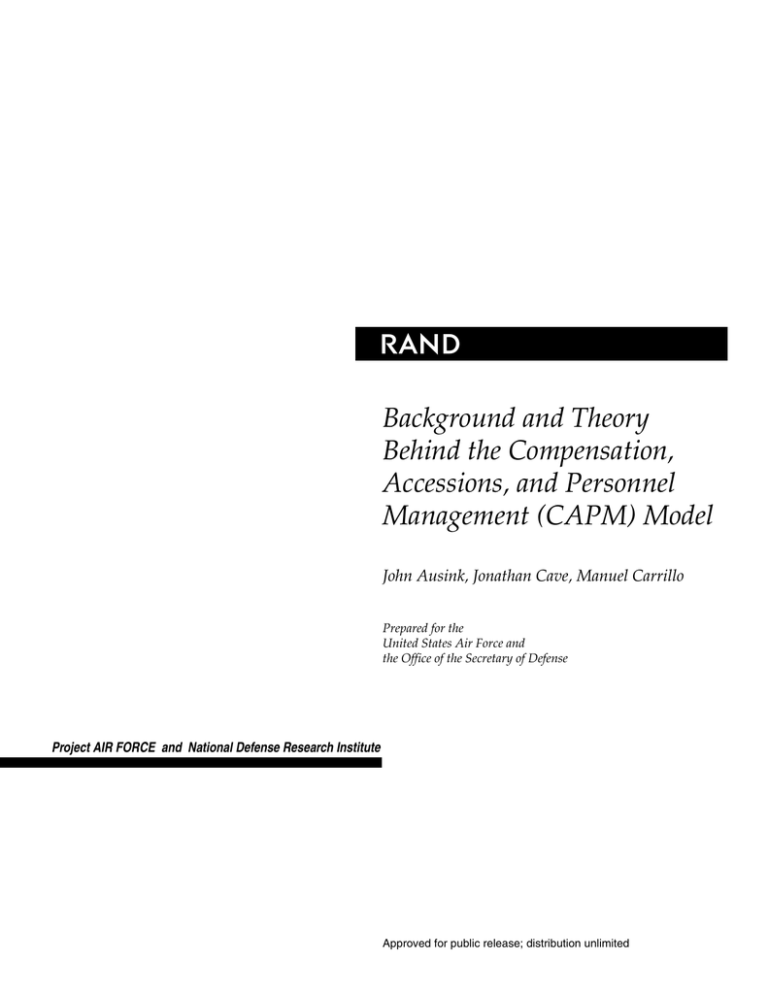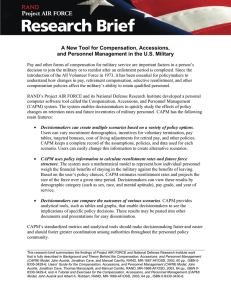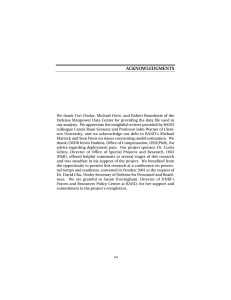
R
Background and Theory
Behind the Compensation,
Accessions, and Personnel
Management (CAPM) Model
John Ausink, Jonathan Cave, Manuel Carrillo
Prepared for the
United States Air Force and
the Office of the Secretary of Defense
Project AIR FORCE and National Defense Research Institute
Approved for public release; distribution unlimited
The research reported here was sponsored by the United States Air Force and by the
Office of the Secretary of Defense (OSD). The research was conducted in RAND’s
Project AIR FORCE, a federally funded research and development center sponsored
by the United States Air Force under Contract F49642-01-C-0003, and in RAND’s
National Defense Research Institute, a federally funded research and development
center supported by the OSD, the Joint Staff, the unified commands, and the defense
agencies under Contract DASW01-01-C-0004.
Library of Congress Cataloging-in-Publication Data
Ausink, John A.
Background and theory behind the compensation, accessions, and personnel
management (CAPM) model / John Ausink, Jonathan Cave, Manuel Carrillo.
p. cm.
“MR-1667.”
ISBN 0-8330-3428-6 (pbk.)
1. United States—Armed Forces—Recruiting, enlistment, etc.—Mathematical models.
2. United States—Armed Forces—Pay, allowances, etc.—Evaluation. 3. United States—
Armed Forces—Personnel management—Mathematical models. 4. Employee retention—
United states—Mathematical models. I. Cave, Jonathan A. K., 1951– II. Carrillo, M. J.
(Manuel J.), 1949– III.Title.
UB323.A94 2003
355.6'1'0973—dc21
2003010697
RAND is a nonprofit institution that helps improve policy and decisionmaking
through research and analysis. RAND ® is a registered trademark. RAND’s publications do not necessarily reflect the opinions or policies of its research sponsors.
© Copyright 2003 RAND
All rights reserved. No part of this book may be reproduced in any form by any
electronic or mechanical means (including photocopying, recording, or information
storage and retrieval) without permission in writing from RAND.
Published 2003 by RAND
1700 Main Street, P.O. Box 2138, Santa Monica, CA 90407-2138
1200 South Hayes Street, Arlington, VA 22202-5050
201 North Craig Street, Suite 202, Pittsburgh, PA 15213-1516
RAND URL: http://www.rand.org/
To order RAND documents or to obtain additional information, contact Distribution
Services: Telephone: (310) 451-7002; Fax: (310) 451-6915; Email: order@rand.org
xi
Summary
Pay and other forms of compensation received for military service are important
determinants of a person’s decision to join the military or to reenlist after an
enlistment period is completed. Since the introduction of the All Volunteer Force
in 1973, understanding the effects of economic issues on the supply, recruitment,
and retention of military personnel has been especially important, and
determining the effects of changes in pay, retirement compensation, selective
reenlistment bonuses, or selective early retirement bonuses is essential for good
decisionmaking in personnel policy matters. This report describes the
Compensation, Accessions, and Personnel Management (CAPM) model, which
was developed to be a relatively easy-to-use personal computer–based analytical
tool that would enable decisionmakers to study the effects of changes in policy
on retention behavior and future inventories of military personnel.
Econometric models of the effects of compensation changes (or other policy
changes that can be expressed as equivalent changes in compensation) on
retention behavior usually make the simple assumption that a rational individual
decides whether or not to stay in the military by comparing the potential
monetary value of staying with the potential monetary value of leaving, and
choosing the most lucrative course of action. Calculations of changes in retention
rates in CAPM are based on one such econometric model called the Annualized
Cost of Leaving (ACOL) model and a modification called the ACOL 2 model.
The mathematical derivations of both models and the advantages and
disadvantages of each are described in Section 2 of this report. Additionally, the
simplifying assumptions made to incorporate ACOL 2 parameters in CAPM are
described (in Section 3). Examples in Appendix A outline some of the limitations
of these assumptions by showing when CAPM may overestimate the effects of
compensation changes when compared with a “true” ACOL 2 approach.
Jonathan Cave originally called CAPM an “architecture” because it is not simply
a computer model; it is an Excel®-based analytic structure that includes
databases, modules written in Visual Basic for Applications (VBA), a graphic
user interface, and a variety of tools to analyze model output.1 These features
are described in order to show how ACOL values are calculated, how ACOL
1Throughout this report, “CAPM,” “CAPM model,” and “CAPM system” will be used
interchangeably to refer to the software package as a whole.
xii
values are used to project inventories, and how CAPM can be used for policy
analysis.2
This report concludes with a discussion of the dynamic retention model (DRM),
an intuitively satisfying model of retention behavior that is computationally
more difficult than the ACOL or ACOL 2 models (see Section 4). When CAPM
was originally developed, the DRM was considered too difficult to implement as
a desktop tool. However, recent RAND research is exploring new approaches to
the DRM that may make the incorporation of a DRM-based module practicable
in future versions of CAPM.
2More detailed examples of how CAPM can be used can be found in the CAPM tutorial and
exercises, MR-1669-AF/OSD.





